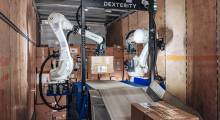In conversation after conversation, we continue to learn of the deep changes that e-commerce has ushered into logistics and transportation practices, from tightening up inventory and fulfillment management to
elevating the importance of final-mile delivery and returns processes—and everything in between.
To respond, logistics professionals now need to leverage diverse systems and new ways of thinking in an effort to improve carrier partnerships and increase speed and efficiency. With that in mind, the editorial staff of LM has put together a collection of features to help readers push that pace of change inside their organizations.
Contributing editor Roberto Michel offers shippers a high-level look at the role that emerging technologies—artificial intelligence (AI), autonomous mobile robots (AMRs) and the Internet of Things (IoT)—are already playing in helping logistics operations approach new ways of managing demands.
“So often it takes an overwhelming phenomenon like e-commerce to bring new technologies into the fold of every-day operations,” says Michel. “In this case, we have shippers under pressure to deliver goods at a faster pace, all while keeping costs under control—an ideal formula to push innovation.”
For example, Michel reports that AI is already working in conjunction within the TMS domain to churn through transactional history, explore current pricing data from carriers, and keep shippers more aware of current weather and traffic data to make more informed freight and routing decisions.
“It’s exciting to see this type of blending of technologies get us to a level of meaningful visibility,” says Michel. “Making sense of data in this way will lead to true efficiencies, and thus make it easier for shippers to make the case for faster adoption internally.”
And that improved visibility and decision-making will only help shippers get a better handle on the parcel and last-mile sectors. Group news editor Jeff Berman offers shippers our annual Parcel Express Roundtable, a print feature that will come alive in a webcast on March 26. Go to logisticsmgmt.com to register.
“The pace of change is accelerating, as costs are rising, delivery locations are shifting and shippers have more last-mile options than ever,” says Berman. “This year’s panel strongly advises that shippers go into parcel discussions well prepared, negotiate for exactly what services are needed, and don’t be afraid to regularly seek improvements.”
Another area to add to the parcel and last-mile discussion: returns management—a segment that many call “the next frontier” for both carriers and shippers alike. Executive editor Patrick Burnson takes a deeper look at the reverse loop, an area that represents the greatest untapped opportunity for imaginative logistics operations.
“I’ve been watching this overlooked area for 10 years,” says Burnson, “and the numbers continue to blow my mind.” According to recent data form Invesp, a retail market analytics and research firm, 30% of all products ordered online are now returned compared to roughly 9% for brick-and-mortar stores.
“That same research shows that 92% of consumers say that they’ll continue to buy from a company that makes the returns process easy,” adds Burnson. “This tells me that an efficient, effective returns process is now table stakes for any retailer. There’s profit and margin tied up in that process that is all too often overlooked.
About the Author
Follow Robotics 24/7 on Linkedin
About the Author
Follow Robotics 24/7 on Linkedin
Article topics
Email Sign Up
















